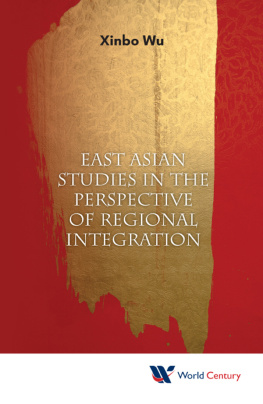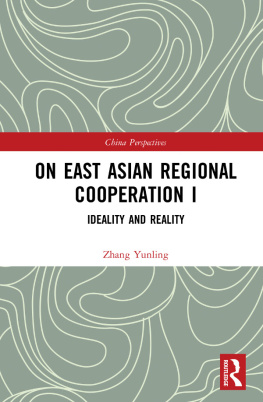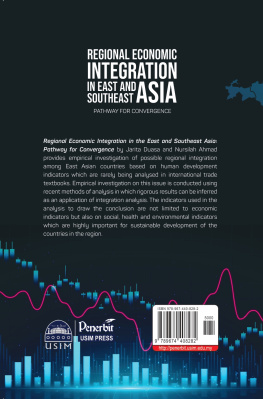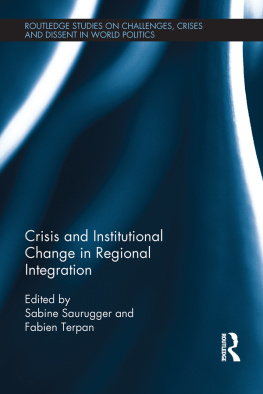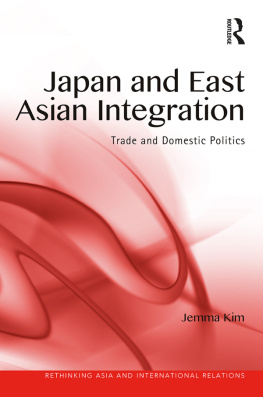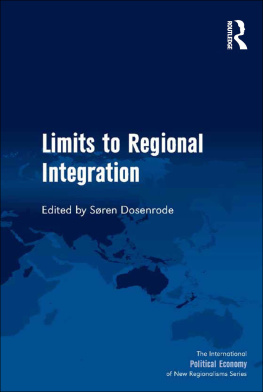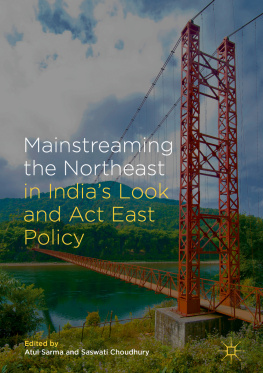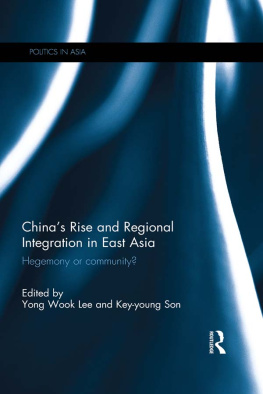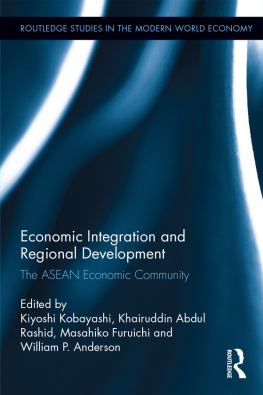

Published by
World Century Publishing Corporation
27 Warren Street, Suite 401-402, Hackensack, NJ 07601, USA
Library of Congress Cataloging-in-Publication Data
Names: Wu, Xinbo, 1966 editor.
Title: East Asian studies in the perspective of regional integration /
edited by Xinbo Wu (Shanghai International Studies University, China).
Description: New Jersey : World Century Publishing Corporation [2017]
Identifiers: LCCN 2017040694 | ISBN 9781938134968
Subjects: LCSH: Regionalism--East Asia. | East Asia--Economic integration. |
Regionalism (International organization) | International economic integration.
Classification: LCC JQ1499.A38 R433446 2017 | DDC 337.1/5--dc23
LC record available at https://lccn.loc.gov/2017040694
British Library Cataloguing-in-Publication Data
A catalogue record for this book is available from the British Library.
Copyright 2018 by World Century Publishing Corporation
Published by arrangement with Shanghai Peoples Publishing House.
All rights reserved. This book, or parts thereof, may not be reproduced in any form or by any means, electronic or mechanical, including photocopying, recording or any information storage and retrieval system now known or to be invented, without written permission from the publisher.
For photocopying of material in this volume, please pay a copying fee through the Copyright Clearance Center, Inc., 222 Rosewood Drive, Danvers, MA 01923, USA. In this case permission to photocopy is not required from the publisher.
For any available supplementary material, please visit
http://www.worldscientific.com/worldscibooks/10.1142/U031#t=suppl
Desk Editor: Dong Lixi
Typeset by Stallion Press
Email:
Printed in Singapore
Preface
East Asia is now experiencing significant economic growth and social change. Integration of East Asia seems an irresistible trend, as East Asian countries are closely interdependent with each other and share many common interests in economic development. This is the internal factor. Externally, globalization and regional integration are also driving force of East Asia cooperation. However, despite of the complementary advantages and group cohesion among East Asian countries, they still face severe challenges brought by global changes. Enhancing the overall status of East Asia in the international arena is a pressing need.
The first Trilateral Symposium was held in Seoul, South Korea in February 2010, attended by scholars from three universities representing the three East Asian countries. The universities are Fudan University of China, Kyung Hee University of Korea and Meijo University of Japan. Up till now, the Trilateral Symposium has been held successfully for six consecutive years and the scale of the symposium has been expanded with each passing year. In the latest symposium, the participants came from more than 10 universities and institutes, including Kyung Hee University, Incheon National University of Korea, Meijo University, Kyushu University, Gifu Keizai University, Nanzan University, Gakushuin University of Japan, Shanghai International Studies University, Fudan University, Shanghai Academy of Social Sciences, and Harbin University of Commerce of China.
This volume compiles 15 papers which were carefully selected from two Symposiums. One was held at Kyung Hee University in Seoul, South Korea in 2013 and the other was at Shanghai International Studies University (SISU) in Shanghai, China in 2014. The edited papers now become chapters in this book. The chapters are divided into four sections. The first section discusses the impact of East Asia cooperation and economic integration. The second section emphasizes the election of political leadership in East Asia. Section three covers topics of East Asian cultural identity, history and norms. Section four addresses the issue of relationship between East Asia and the world.
The editors of this volume are most grateful to the contributors, whose fine work and enthusiasm made the completion of this book possible. This volume would never be such fruitful without the intellectual passion presented by each author Hiroki Miura, Hong Pyo Lee, Seongyi Yun, Jiang Xudong, Kwangwook Kim, Yeawon Kim, Wu Xinbo, Wu Di, Yoko Yoshikawa, Bao Xiaqin, Fang Xiuyu, Li Li, He Ping, Kang Chengwen, Liu Hongsong, Zhang Jian, and Yuri Sadoi. We also thank the anonymous reviewers for their encouragements and suggestions for revision.
In November 2015, SISU Trilateral Cooperation Studies Center was founded by Chinese Ministry of Foreign Affairs within the Trilateral Cooperation Framework. It shows that China is paying increasing attention to the studies of East Asian cooperation. Colleges, universities and research institutes in China, South Korea and Japan will continue to hold regular meetings. The continuous intellectual interaction will drive the trilateral cooperation in areas of higher education, political, economic and cultural exchanges for substantial progress, as well as provide concrete foundation for international friendship making.
East Asian Cooperation and its Economic Integration
Chapter 1
Sino-Japanese Cooperation in Economic Integration of East Asia
Zhang Jian
Introduction
The economic integration of East Asia after WW II is the result of the transformation of foreign trade strategy of the regions largest economy Japan in the 1980s. The direct reason of Japanese foreign trade strategic transformation is the higher yen, trade friction and demand for upgrading of industrial structure. In that context, Japan strived to build Flying Geese Pattern (Kojima, 2004), speeding up direct investment in East Asia including ASEAN, South Korea and China which has played a promoting role in the development of export-oriented economy, and it also increased the economic dependence among East Asian countries and regions, promoting the development of economic and trade integration in East Asia. But since the sustained and rapid growth of Chinese economy in East Asia in 21st century with its gross domestic product (GDP) of 2010 exceeding Japan and becoming the regions leading economic power, the original East Asian economic cooperation system dominated by Japan is hard to adapt to present situation and meet the need of regional development. Thus, the new East Asia economic integration framework system cannot wait to be built. As the first and second largest economy in this region, how could China and Japan participate and cooperate to promote the construction of regional economic cooperation mechanism becomes the key point of promoting the regional economic integration naturally. This thesis takes Sino-Japan cooperation in the process of the integration as the research object, to investigate and analyze the following questions. First, the status quo and characteristics of economic integration in East Asia; second, the comparison of cooperation mechanism and frameworks in the areas that the two countries have participated in respectively; third, their focus and position on the issue of the regional economic integration. On the basis of investigation and analysis of the above problems, they try to think about the problems and prospects in constructing the effective East Asias economic integration cooperation mechanism.



